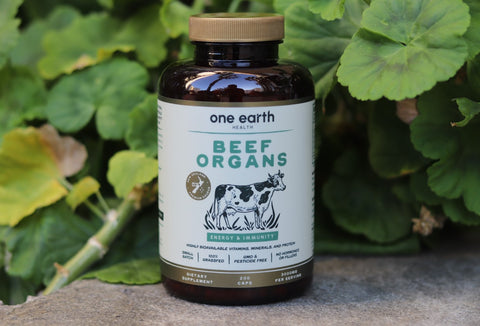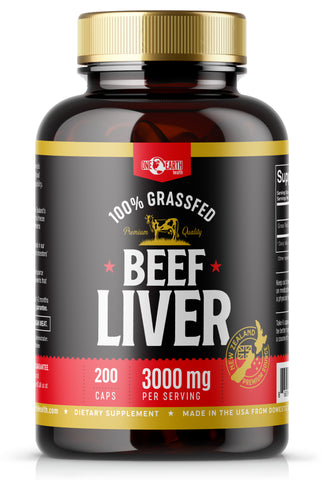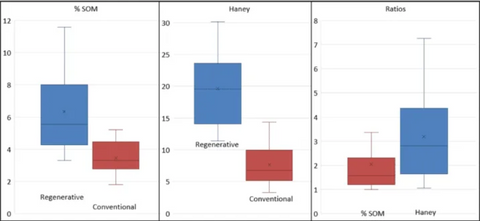What Is Regenerative Farming?
Regenerative farming is an agricultural approach that prioritizes the health of the soil, ecosystems, and the surrounding environment. It is the key to nutrient-dense food and a thriving planet.
At One Earth Health, we believe in the power of regenerative farming to nourish both people and the Earth. Our high-quality, grass-fed beef organ supplements provide you with the concentrated nutrients your body needs to thrive.
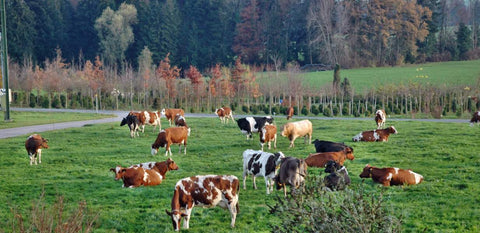
Article jumplinks:
What are the practices of regenerative farming?
How does regenerative farming work?
The benefits of regenerative farming
The disadvantages of regenerative farming
What is the cost of regenerative agriculture
Why is regenerative agriculture so important?
Regenerative farming vs conventional farming
Where to get the best beef organ supplements
Experience the benefits of our top-quality beef organ products, sourced from regenerative farms that are committed to the health of both the land and the animals. Our beef organ supplement provides a powerful blend of vitamins, minerals, and essential nutrients in an easy-to-take capsule.
More About Regenerative Agriculture
Regenerative farming, also known as regenerative agriculture, is a holistic approach to farming that focuses on improving and regenerating the health of the soil, ecosystem, and surrounding community. It goes beyond sustainable farming practices by prioritizing the health and vitality of the entire ecosystem.
The well-being of our food, our communities, and our planet are all interconnected. By focusing on nurturing the soil, promoting biodiversity, and working with nature's rhythms, regenerative farmers aim to create thriving, resilient agricultural systems that can sustain us for generations to come.
Regenerative agriculture is not a novel concept. Indigenous communities have been farming in harmony with nature for thousands of years. An article published by the Natural Resources Defense Council (NRDC) explains that the “regenerative agriculture movement is the dawning realization among more people that an Indigenous approach to agriculture can help restore ecologies, fight climate change, rebuild relationships, spark economic development, and bring joy.”
At One Earth Health, we've recognized the importance of regenerative farming, and that's why we create our beef organ supplement using only the highest quality, 100% grass-fed and finished beef from regenerative farms. We’re not just providing you with a powerful source of nutrition, but also contributing to the health and resilience of our planet and its people.
What Are the Practices of Regenerative Farming?
Regenerative agriculture practices are based on improving the health of the land, its crops, and the communities. Here are the environmentally friendly practices regenerative agriculture is based on:
- Cover cropping. Regenerative farmers plant cover crops between main crop rotations. This protects and enriches the soil. The cover plants prevent erosion, suppress weeds, and add organic matter to the soil when they decompose.
- Crop rotation. This refers to alternating the types of crops grown in each field every season. With crop rotation, farmers can disrupt pest and disease cycles, reduce the need for synthetic inputs, and promote soil health.
- Reduced tillage. No-till or minimal tillage farming reduces soil disturbance, helps preserve soil structure, reduces erosion, and promotes the growth of beneficial soil microorganisms.
- Composting. Compost in the soil adds essential nutrients, improves soil structure, and retains moisture.
- Integrating livestock. When you bring animals into the farming system, they can aid in managing weeds, fertilize the soil with manure, and promote biodiversity.
- Agroforestry. Trees and shrubs in the agricultural landscape provide habitat for wildlife, aid in water and nutrient cycle regulation, and can even provide additional income streams for farmers.
- Precision irrigation. When you incorporate efficient, targeted irrigation techniques, you conserve water, reduce runoff, and ensure your crops get the moisture they need without waste.
- Biological pest control. Regenerative farming uses natural pest control methods to keep crop-damaging pests in check without resorting to harmful chemical pesticides.
Regenerative agriculture is more than just a set of practices; it's a mindset that embraces the self-healing power of nature and the key to a healthier, more sustainable future.
How Does Regenerative Agriculture Work?
Regenerative agriculture works by leveraging natural processes and ecological principles to create a self-sustaining, resilient system that benefits both the environment and the farmer. At its core, regenerative agriculture focuses on:
- Soil health
- Biodiversity
- Nutrient cycling
Soil Health as the Foundation of Regenerative Agriculture
Soil health is the foundation of a thriving agricultural system. Healthy soil is teeming with life, diverse microorganisms, fungi, and other organisms that work together to cycle nutrients, improve soil structure, and support plant growth. Regenerative agriculture nurtures and supports this complex web of life by minimizing soil disturbance, keeping the soil covered, and providing a diverse array of organic matter inputs.
Diversity In Regenerative Agriculture
Biodiversity is essential for fostering ecosystem resilience. In natural ecosystems, diversity provides a buffer against stress and disturbance, which allows the system to adapt and recover more quickly. Regenerative agriculture tries to mimic this diversity by cultivating a wide range of crops and integrating livestock into the system. This not only helps to mitigate risk and reduce the impact of pests and diseases, but also creates opportunities for beneficial interactions between different components of the system.
Nutrient Cycling Optimizes Nature’s Processes
Regenerative agriculture recognizes the importance of nutrient cycling in maintaining soil health and productivity. In conventional agriculture, nutrients are often added to the soil in the form of synthetic fertilizers. This can lead to imbalances and excessive losses through leaching and runoff.
Regenerative agriculture optimizes nutrient cycling by relying on organic matter inputs, such as compost and animal manures, and by promoting the growth of nitrogen-fixing plants that can capture atmospheric nitrogen and make it available to other crops.
The Socio-Economic Aspects of Regenerative Farming
By prioritizing soil health and biodiversity, regenerative farms can be more resilient to climate fluctuations and market volatility. This significantly reduces the risk of crop failure and provides a more stable income for farmers. Regenerative agriculture also emphasizes local food systems and direct relationships between farmers and consumers, which paves the way for community building and economic development.
By embracing regenerative farming practices, One Earth Health has crafted the finest organic, 100% grass-fed beef organ supplements. When you choose One Earth Health's supplements, you're supporting a holistic approach to agriculture that prioritizes soil health, biodiversity, and nutrient-rich food.
Order our beef liver capsules and enjoy this easy way to supercharge your health with a concentrated source of vital nutrients. Read more about the phenomenal health benefits of beef liver.
What Are the Benefits of Regenerative Agriculture?
Regenerative farming offers a wealth of benefits that extend far beyond the farm itself. In 2021, Giller, et. al. critically examined the regenerative agriculture movement and mentioned a few potential benefits of regenerative farming such as:
- Potential to improve soil health, increase organic matter concentration, and promote soil biodiversity.
- Reduction in the use of synthetic fertilizers and pesticides, which could benefit the environment.
- Implementation of “good agricultural practices” such as cover cropping, crop rotation, and reduced tillage.
- Potential to sequester carbon in the soil, mitigating climate change.
The advantages don't stop there. Here is a more comprehensive list of the benefits of regenerative agriculture:
- Regenerative practices create healthier soil rich in organic matter and teeming with beneficial microbes. This improves soil structure, increases water retention, and reduces erosion—all beneficial for the land and the crops.
- Diverse crop rotations, cover crops, and integrating livestock support biodiversity. This means more habitats for different species and a balanced and resilient ecosystem that can better handle challenges.
- Minimizing tillage, using cover crops, and planting perennials sequester carbon in the soil. This is a big deal because it helps to mitigate climate change and creates a healthier environment for everyone.
- Instead of synthetic fertilizers and pesticides, regenerative agriculture relies on natural processes and organic amendments to nourish and protect crops. This means less environmental pollution and a healthier food system overall.
- With healthier soils and diverse ecosystems, regenerative farms are more resilient to extreme weather, pests, and diseases. They have more stress-resistance and can maintain productivity, even in challenging times.
- Regenerative practices help the soil absorb and hold more water, reducing runoff and using water more efficiently. This is important for managing drought and flooding risks.
- Regenerative agriculture often focuses on local markets and community engagement. This creates a more connected and resilient food system that supports the surrounding community and builds stronger relationships between farmers and consumers.
- Healthy soils grow healthier plants and breed healthier animals. Regenerative practices lead to higher-quality, more nutrient-dense food that's better for everyone.
When you combine all the beneficial factors of regenerative farming, you get an approach to agriculture that contributes to a stronger environment and a better outlook on human health. It's a win-win for people and the planet.
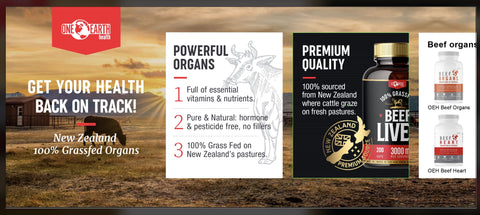
Are There Any Disadvantages to Regenerative Farming?
Regenerative farming is all upside. If there is a downside, it would be the inertia of conventional agriculture and its reliance on non-regenerative methods. Farmers may have trouble making the leap. The study by Giller, et. al. examined some of the friction points with adopting regenerative practices, and found the following:
- It takes time (often several years) to convert from conventional to regenerative farming practices and see the desired results. During this transition, farmers may experience temporary yield reductions or increased costs.
- Farmers might need some extra guidance, training, and support to really nail down these new practices.
- When you start implementing regenerative practices, you may require significant upfront investments in seeds, equipment, fencing, or additional labor.
- Some regenerative practices can be more labor-intensive than conventional methods, which may increase labor costs or require more time from the farmer.
- The effectiveness of regenerative practices depends on soil type, climate, and topography. What works well in one region may be less successful in another, requiring farmers to adapt their approach to their situation.
- Regenerative agriculture is still an emerging field, and farmers may face challenges in accessing technical assistance, financing, or government support programs tailored to their needs.
- Some farmers may be hesitant to adopt regenerative practices due to cultural, social, or economic factors.
- It's not always clear how regenerative practices can be profitable and socially acceptable in different contexts, which is important for farmers to adopt them successfully.
According to a survey done by the Boston Consulting Group, farmers aren't against regenerative agriculture, but they have some reservations about making the switch. These include:
- Potential yield drops, upfront expenses, and inadequate crop protection during the transition. The current insurance and subsidy system favors conventional farming, leaving farmers to shoulder most of the risks associated with adopting regenerative practices.
- Lack of the necessary technical support and resources to successfully transition to regenerative agriculture.
- Significant pressure from their peers to stick with conventional farming methods.
Despite these challenges, many farmers and advocates believe that the long-term benefits of regenerative agriculture outweigh the short-term obstacles.
What Is the Cost of Regenerative Farming?
The initial costs of going regenerative might seem daunting. Regenerative agriculture offers a ton of long-term benefits, but making the switch can come with some upfront expenses. Some of the biggest challenges for farmers going regenerative include:
- The investment in new equipment, such as no-till machinery
- Higher costs for seeds, fuel, and labor
- Crop yields can sometimes take a hit during the transition period
But even with these upfront costs, regenerative agriculture provides serious economic benefits in the long run. The Boston Consulting Group predicts “a potential 15%–25% return on investment for farmers once they have shifted from conventional agriculture to incorporating more regenerative practices at scale.”
As farmers build healthier soil, they often find that they need far fewer external inputs (e.g., fertilizers and pesticides), which can really cut down on their production costs. A Forbes article claims that regenerative farms can be up to 78% more profitable than conventional ones.
By improving the land with regenerative practices, farmers increase the value of their most important asset. As a bonus, regenerative techniques can help farms become more resilient to climate change by improving water infiltration and soil carbon sequestration.
Why Is Regenerative Agriculture Important?
Regenerative farming isn’t just about producing food sustainably. It's about actively improving the health of our planet. By working with nature, regenerative agriculture practices can help us tackle some of the biggest challenges of our time, from carbon sequestration and biodiversity loss to soil erosion and water scarcity.
A 2017 review emphasizes the importance of regenerative agriculture in improving soil health, increasing organic carbon in the soil, enhancing water quality, and boosting land productivity.
Regenerative agriculture has at its core the intention to improve the health of soil or to restore highly degraded soil, which symbiotically enhances the quality of water, vegetation, and land productivity. By using methods of regenerative agriculture, it is possible not only to increase the amount of soil organic carbon (SOC) in existing soils, but to build new soil.
Here’s why regenerative agriculture is important:
- Regenerative practices can help sequester carbon in the soil, reducing greenhouse gas emissions.
- Regenerative farming enhances soil fertility, structure, and water retention.
- It can improve crop yields and resilience, ensuring a more stable and nutritious food supply for a growing population.
- Healthy soils can better absorb and filter water, reducing runoff and preventing water pollution from chemical inputs.
- Regenerative practices—such as diversifying crops, integrating livestock, and reducing chemical use—create habitats for beneficial insects, pollinators, and wildlife.
- It minimizes the need for synthetic fertilizers and pesticides, decreasing the carbon footprint of food production.
- It can create more resilient and profitable farms, revitalize rural economies, and support the livelihoods of farmers.
- Regenerative systems are more resilient to extreme weather events, helping farmers adapt to the impacts of climate change.

Regenerative Agriculture vs Conventional Farming
Conventional farming prioritizes maximizing crop yields in the short term, often at the expense of soil health and biodiversity. This approach relies heavily on synthetic fertilizers, pesticides, and frequent plowing, which lead to soil degradation, reduced fertility, and chemical runoff.
Regenerative agriculture takes a holistic approach, focusing on restoring and enhancing soil health, biodiversity, and ecosystem services for long-term sustainability. Regenerative practices rebuild soil structure, improve water retention, and promote nutrient cycling. These methods also incorporate diverse crops, livestock, and native plants to enhance ecosystem function and resilience while minimizing chemical use and carbon emissions.
A 2004 study found that crops with bigger yields, pest resistance, and climate adaptability don’t seem to give enough nutrients. Farmers in the past two decades have been neglecting nutrition, prioritizing shelf life, availability, and consistency.
Meat from regenerative farms is healthier and more nutrient-dense than that from conventional farms. On regenerative farms, the animals have access to diverse pastures rich in nutrients, so they produce meat with higher levels of essential vitamins, minerals, and healthy fats.
After comparing soil health and crop nutrient density between regenerative and conventional farms, a 2022 study found that regenerative practices can improve soil organic matter, soil health scores, and the vitamin, mineral, and phytochemical content of crops and livestock.
…healthier soil with more soil organic matter and the life it sustains can enhance the nutrient-density of crops, increasing levels of micronutrients and phytochemicals through, we suspect, influencing nutrient cycling as well as biochemical signaling involved in phytochemical production.
The study also found that regeneratively raised meat had healthier fatty acid profiles compared to conventional and grass-fed meat: ”regenerative farms that combined no-till, cover crops, and diverse rotations…produced crops with higher soil organic matter levels, soil health scores, and levels of certain vitamins, minerals, and phytochemicals.”
The Regeneration, a Substack publication devoted to regenerative agriculture, makes the following claims, with some evidence provided to back them up:
- Crops from regenerative farms have 11-34% higher levels of vitamins (E, K, B1, B2) and minerals (calcium, phosphorus, and copper) compared to conventional farms. Crops from regenerative farms had 15-22% more beneficial phytonutrients.
- Beef from regenerative farms had 3 times more omega-3 fatty acids and over 6 times more alpha-linolenic acid (an essential omega-3) compared to conventional beef.
- Pork from regenerative farms had 11 times more alpha-linolenic acid (ALA) and 2 times more eicosapentaenoic acid (EPA) compared to conventional pork.
- Healthier soils on regenerative farms are the key driver of the increased nutrient density in crops and livestock.
Soil health metrics for regenerative and conventional farms. Source: https://weekly.regeneration.works/p/are-regeneratively-raised-foods-healthier
Regenerative agriculture is the beacon of sustainable farming practices. At One Earth Health, we prioritize soil health, biodiversity, and nutrient-rich food production to create the healthiest, most nutrient-dense beef organs.
We source our meat from New Zealand regenerative family farms where livestock graze freely on lush pastures. That means no synthetic pesticides, GMOs, or other harmful chemicals interfering with the natural goodness of our products. When you choose our supplements, you're not just investing in your health; you're supporting a movement towards a more sustainable and nourishing future for our planet.
Read more about why New Zealand beef is superior in quality and taste.
Why New Zealand?
New Zealand stands out as a regenerative farming haven. Beef raised in New Zealand is often considered a cut above the rest. Here are a few reasons why:
- Its pristine landscapes offer vast expanses of untouched nature, perfect for nurturing organic, family-run operations dedicated to regenerative agriculture. The country's temperate climate and abundant rainfall provide ideal conditions for lush pastures, allowing livestock to graze freely year-round.
- New Zealand's strict environmental regulations and commitment to sustainable farming practices ensure that these regenerative farms prioritize soil health, biodiversity, and the well-being of both animals and ecosystems.
- New Zealand has an "entrepreneurial" and innovative culture that has enabled the development of regenerative farming practices.
From the rolling hills of the North Island to the rugged beauty of the South Island, New Zealand is teeming with passionate farmers dedicated to producing high-quality, nutrient-rich meat while preserving the land for future generations.
It's not just about what goes into our products; it's about the values and principles upheld by the farmers who make it all possible.

Get the Best Beef Organ Supplements
At One Earth Health, we believe in the power of regenerative farming to heal both people and the planet. We source our grass-fed beef organ supplements exclusively from small family farms in New Zealand that practice regenerative agriculture. These farms work with nature, not against it, to build healthy soil, promote biodiversity, and produce the most nutrient-dense food possible.
By supporting regenerative farming, we're not just providing you with the highest quality organ supplements on the market—we're also helping to combat climate change, conserve water, and revitalize rural communities. Our supplements are packed with essential vitamins, minerals, and protein, giving you all the benefits of nose-to-tail nutrition in a convenient capsule form.
So when you choose One Earth Health, you're not just investing in your own health; you're also supporting a brighter, more sustainable future for all. Try our grass-fed beef organ capsules and feel the difference that regenerative farming can make
Regenerative Farming FAQ
What is regenerative farming philosophy?
Regenerative farming is a holistic approach to agriculture that aims to restore and enhance ecosystem health while promoting long-term sustainability. Unlike conventional farming, which often depletes soil health and relies heavily on synthetic inputs, regenerative farming focuses on building soil fertility, enhancing biodiversity, and minimizing environmental impact. It prioritizes practices such as cover cropping, crop rotation, no-till farming, and integration of livestock to improve soil structure, water retention, and nutrient cycling, resulting in resilient and thriving ecosystems.
What is the best method of farming?
The best method of farming depends on environmental conditions, soil type, and the specific goals of the farm. Regenerative agriculture is gaining recognition as a leading approach due to its focus on sustainability, soil health, and ecosystem restoration. By nurturing the land and working with natural processes, regenerative farming not only produces healthy food but also helps mitigate climate change, conserve water, and promote biodiversity.
What are the tools used in regenerative agriculture?
Regenerative farming employs a range of tools and practices to enhance soil health, biodiversity, and ecosystem resilience. Some common tools include:
- Cover crops, which protect the soil from erosion and add organic matter.
- Crop rotation, which diversifies plant species and prevents nutrient depletion.
- No-till or reduced tillage, which minimizes soil disturbance and retains soil structure.
- Holistic grazing management, which mimics natural grazing patterns to improve soil fertility and biodiversity.
Which farming is most profitable?
While profitability can vary depending on factors such as market demand, input costs, and management practices, regenerative farming has shown promising potential for profitability over the long term. By reducing reliance on expensive inputs like synthetic fertilizers and pesticides, regenerative farmers can lower production costs while improving soil health and productivity. Regeneratively produced goods often command premium prices in markets that value sustainability and quality.
Which farming method is the most sustainable?
Regenerative agriculture is widely regarded as one of the most sustainable farming methods available today. Unlike industrial agriculture, which can degrade soil, pollute waterways, and contribute to climate change, regenerative farming focuses on restoring and enhancing ecosystem health. By building organic matter levels in the soil, sequestering carbon, promoting biodiversity, and conserving water, regenerative agriculture addresses key environmental challenges while providing a foundation for long-term food security and resilience.
What type of land is best for farming?
The best type of land for farming varies depending on factors such as climate, soil fertility, and water availability. Land with healthy soils and sufficient water resources is generally well-suited for farming. Regenerative agriculture practices can improve soil health and productivity on a wide range of land types, including degraded soils and marginal lands. By restoring ecosystem function and enhancing soil fertility, regenerative farming can unlock the productive potential of diverse landscapes while promoting environmental sustainability.
Resources
Regenerative Agriculture 101. (2021, November 29). https://www.nrdc.org/stories/regenerative-agriculture-101#what-is
Giller, K. E., Hijbeek, R., Andersson, J. A., & Sumberg, J. (2021). Regenerative Agriculture: An agronomic perspective. Outlook on Agriculture, 50(1), 13-25. https://doi.org/10.1177/0030727021998063
Bugas, J., Conant, H., Hoo, S., Bellino, F., Unnikrishnan, S., & Westerlund, M. (2023, August 15). Making Regenerative Agriculture Profitable for US Farmers. BCG Global. https://www.bcg.com/publications/2023/regenerative-agriculture-profitability-us-farmers
Milinchuk, A. (2020, February 4). Is Regenerative Agriculture Profitable? Forbes. https://www.forbes.com/sites/forbesfinancecouncil/2020/01/30/is-regenerative-agriculture-profitable/?sh=24d88c98cdf2
Davis DR, Epp MD, Riordan HD. Changes in USDA food composition data for 43 garden crops, 1950 to 1999. J Am Coll Nutr. 2004 Dec;23(6):669-82. doi: 10.1080/07315724.2004.10719409. PMID: 15637215.
Montgomery, D. R., Biklé, A., Archuleta, R., Brown, P. L., & Jordan, J. (2022, January 27). Soil health and nutrient density: preliminary comparison of regenerative and conventional farming. PeerJ. https://doi.org/10.7717/peerj.12848
Chatham, M. (2022, June 17). Are regeneratively raised foods healthier? The Regeneration. https://weekly.regeneration.works/p/are-regeneratively-raised-foods-healthier
